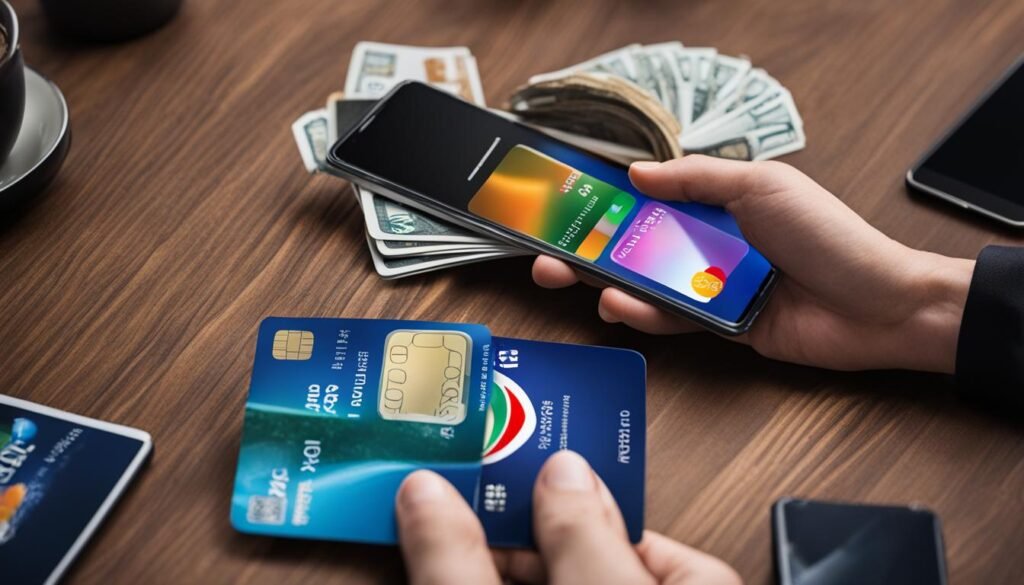When it comes to making transactions, there are various payment methods available today. These methods have evolved over time to meet the needs of customers in the digital age. From online payment systems to mobile payment methods and digital wallets, there are a plethora of options to choose from.
In this article, we will explore the rise of popular payment methods, their security features, convenience, and impact on e-commerce. I will also compare different types of electronic payment methods and discuss emerging trends in payment preferences and consumer behavior. Additionally, I will delve into the world of cryptocurrency payments and provide insights on choosing the right payment solutions for businesses. By the end of this article, you will have a comprehensive understanding of the diverse payment options available in today’s digital landscape.
Table of Contents
Key Takeaways:
- There are various payment methods available today, ranging from online payment systems to mobile payment methods and digital wallets.
- Popular payment methods offer security features and convenience, making them preferred options for e-commerce transactions.
- Different types of electronic payment methods cater to varying user preferences and needs.
- Credit cards and debit cards still hold strong as widely used forms of payment.
- Emerging payment technologies, such as cryptocurrency, are shaping the future of payments.
Understanding the Evolution of Payment Methods
Payment methods have evolved significantly over time, transforming from traditional methods like cash and checks to the digital solutions we have today. With the advancement of technology and the rise of the internet, the way we make transactions has changed dramatically. In this section, we will explore the history of payment methods and how they have adapted to meet the needs of the modern era.
In the early days, traditional payment methods such as cash were the most common form of exchange. However, as society became more complex and transactions grew in volume, new methods were needed to facilitate commerce. This led to the introduction of checks, which provided a convenient way to transfer funds without the need for physical currency.
The emergence of the internet paved the way for a new era of payment methods. Digital payment solutions, such as credit and debit cards, came into existence, offering a safer and more convenient way to make transactions. These methods quickly gained popularity and became widely accepted in both online and offline transactions.
Over time, modern payment methods have continued to evolve, embracing emerging technologies and addressing consumer needs. Mobile payment methods, for example, have gained widespread adoption, allowing users to make payments using their smartphones or mobile devices. This has revolutionized the way people shop and engage in transactions, offering a seamless and convenient experience.
Today, we have a wide range of payment solutions available to us, each with its own set of advantages and features. From digital wallets to online payment systems and even cryptocurrencies, the options are diverse and cater to the needs of different individuals and businesses.
As the digital landscape continues to evolve, it is essential to stay informed about the latest trends and developments in payment methods. In the following sections, we will take a closer look at specific payment solutions, their security features, convenience, and the impact they have on e-commerce and consumer behavior. By understanding the evolution of payment methods, we can make informed decisions about the best solutions for our personal and business needs.
The Rise of Online Payment Systems
Online payment systems have revolutionized the way we make transactions in the digital age. With the convenience of secure online payments and trusted payment systems, consumers can now effortlessly complete transactions over the internet. The rise of online payment systems has had a significant impact on e-commerce, enabling businesses to expand their reach and offer convenient payment options to customers worldwide.
Secure Payment Options: Ensuring Customer Trust Online
One of the key benefits of online payment systems is the presence of secure payment options that prioritize customer trust and protection. These systems employ advanced encryption technologies and robust security measures to safeguard sensitive financial information, ensuring that customer data remains confidential and protected from unauthorized access. With secure online payments, customers feel confident in sharing their payment details, leading to increased trust and loyalty towards online retailers.
Convenient Payment Options: A Look at User-Friendly Interfaces
Online payment systems also offer user-friendly interfaces, making the payment process seamless and hassle-free. With intuitive designs and easy-to-navigate interfaces, customers can quickly and efficiently complete their transactions without encountering any technical difficulties. Whether it’s selecting payment methods, entering card details, or confirming payments, user-friendly payment interfaces simplify the entire process, enhancing the overall customer experience and encouraging repeat business.
| Benefits of Online Payment Systems | Advantages of Secure Payment Options | Features of User-Friendly Interfaces |
|---|---|---|
| 1. Convenience of making transactions from anywhere, anytime | 1. Protection of customer data through advanced encryption | 1. Intuitive designs for easy navigation |
| 2. Speedy processing and instant confirmation of payments | 2. Enhanced trust and confidence from customers | 2. Simplified payment process to minimize user errors |
| 3. Wide range of accepted payment methods for flexibility | 3. Prevention of fraudulent activities and unauthorized access | 3. Mobile-responsive interfaces for seamless mobile payments |
The Impact of E-Commerce Growth on Payment Solutions
The rapid growth of e-commerce has had a profound impact on the way we make payments. With more and more people shopping online, there is a rising demand for secure and convenient payment solutions that cater to the needs of digital consumers. The revolutionizing effects of e-commerce have led to significant changes in the payment landscape, prompting the industry to adapt and innovate.
Online transactions have become the norm, offering unparalleled convenience and accessibility. Shoppers can now make purchases from the comfort of their homes, browse through a wide range of products, and compare prices with just a few clicks. As a result, traditional payment methods have been transformed, paving the way for new and efficient ways of conducting financial transactions.
The changing payment landscape has given rise to a plethora of innovative payment methods, revolutionizing the way we pay. From mobile wallets and digital wallets to contactless payments and cryptocurrencies, consumers now have a diverse range of options to choose from. These methods not only offer convenience but also provide enhanced security measures to protect sensitive financial information.
“The growth of e-commerce has not only changed the way we shop but also how we pay. It has led to the emergence of new payment solutions that prioritize convenience and security.” – [Real-name]
Businesses, too, have had to adapt to this changing landscape. They now need to incorporate and offer a wide variety of payment options to meet the demands of their digital customers. Providing secure and easily accessible payment solutions has become a critical factor in capturing and retaining customers in the highly competitive e-commerce industry.
As e-commerce continues to grow, so does the need for innovative payment solutions that meet the evolving requirements of online shoppers. The changing payment landscape has created opportunities for businesses and consumers alike, ushering in a new era of secure, convenient, and efficient payment methods.
With the continuous evolution of e-commerce and advancements in payment technology, the future looks promising for the payment industry. As consumers’ expectations shift and new trends emerge, we can expect further developments in payment solutions, ultimately shaping the way we transact in the digital age.
Mobile Payment Methods: The Path to the Future
As smartphones become an essential part of our daily lives, mobile payment methods are rapidly gaining popularity. With the convenience of mobile wallets and contactless payment options, making transactions has never been easier.
Mobile wallets, such as Apple Pay and Google Pay, allow users to securely store their payment information on their smartphones. This eliminates the need to carry physical wallets or credit cards, streamlining the payment process. With just a few taps on their phone, users can make purchases in-store, online, or through mobile apps.

The rise of contactless payments has further accelerated the adoption of mobile payment methods. With contactless payments, users can simply tap their smartphones on compatible payment terminals to complete a transaction. This seamless and effortless approach to payments not only saves time but also reduces the need for physical contact, making it particularly convenient in today’s health-conscious environment.
Smartphones play a pivotal role in shaping the future of payment solutions. Their advanced technology allows for secure authentication methods, such as fingerprint or facial recognition, ensuring the safety of transactions. Additionally, smartphones enable the integration of loyalty programs and rewards into mobile payment apps, enhancing the overall customer experience.
The future of payments lies in the continued innovation and evolution of mobile payment methods. As technology continues to advance, we can expect further enhancements in security, accessibility, and functionality. With the convenience and versatility they offer, mobile payment methods are poised to revolutionize the way we make transactions and pave the way for a cashless society.
Comparing Different Types of Electronic Payment Methods
When it comes to electronic payment methods, there are a variety of options to choose from. Each type of payment method has its own unique features and advantages. In this section, we will compare different electronic payment methods, discussing their pros and cons, and shed light on digital payments and online transactions.
“The variety of electronic payment methods allows consumers to select the most suitable option based on their needs and preferences.”
One commonly used electronic payment method is credit cards. Credit cards offer convenience and accessibility, allowing users to make purchases now and pay later. They are widely accepted both online and in physical stores.
Another popular payment method is debit cards. Debit cards provide a direct and secure way to make payments by deducting funds directly from the cardholder’s bank account. They are a convenient choice for those who prefer to avoid credit card debt.
Mobile payment methods, such as mobile wallets and contactless payments, have also gained popularity. With mobile wallets, users can store their payment information securely on their smartphones and make payments with just a tap. Contactless payments allow users to make transactions by simply tapping their cards or phones on a payment terminal.
Electronic payment methods also include digital wallets and e-wallets. These platforms provide a secure and convenient way to store payment information and make transactions online. They often offer additional features such as loyalty programs and rewards.
Account-to-account (A2A) payments have gained traction as well, especially for transferring funds between bank accounts. A2A payments offer immediate fund availability and are particularly useful for real-time transactions.
It is important to consider the advantages and disadvantages of each electronic payment method based on factors such as security, convenience, and acceptance. By comparing different types of electronic payment methods, consumers can make informed decisions that align with their preferences and needs.
In the next section, we will delve into the popularity of credit card transactions in global markets and explore the security features and user protection measures in place to ensure safe transactions.
Credit Card Transactions: Still Holding Strong
Despite the rise of alternative payment methods, credit cards remain one of the most widely used forms of payment worldwide. The convenience, security features, and user protection measures associated with credit cards have solidified their popularity in global transactions. In this section, we will delve into the enduring allure of credit cards and explore their advantages in today’s digital landscape.
The Popularity of Credit Cards in Global Transactions
Credit cards have gained widespread acceptance globally, becoming a preferred method of payment for both consumers and businesses. Their versatility and acceptance across a wide range of merchants make credit cards a convenient option for making online and offline purchases. The ability to carry out transactions around the world without the need for physical currency or local currencies has significantly contributed to their popularity.
Moreover, credit cards offer various benefits such as rewards programs, cashback offers, and loyalty points. These incentives further incentivize consumers to use credit cards, as they can earn valuable perks and discounts while making their regular purchases.
Credit Card Security Features and User Protection
Credit cards prioritize the security and protection of users’ financial information. They implement several security features to ensure the safe processing of transactions. One such feature is the use of encrypted data transmission, which safeguards cardholder data from potential breaches during online transactions. Additionally, credit cards often offer fraud protection services that monitor and detect suspicious activities, providing users with an added layer of security.
Furthermore, credit card users benefit from various consumer protection measures, such as chargeback rights. In the event of fraudulent or unauthorized transactions, users have the ability to dispute charges and seek resolution through their credit card issuer. This provides peace of mind and reassurance to customers, knowing that they have recourse in the face of fraudulent activity.
Overall, credit cards continue to play a pivotal role in global transactions, offering convenience, security, and user protection. Let’s explore further in the table below:
| Advantages of Credit Cards |
|---|
| Convenience: Accepted globally by a wide range of merchants |
| Rewards Programs: Earn perks, cashback, and loyalty points |
| Security Features: Encrypted data transmission and fraud protection |
| User Protection: Chargeback rights and resolution options |
As illustrated in the table above, credit cards offer a range of advantages that make them a preferred choice for consumers worldwide. The combination of convenience, rewards, security features, and user protection measures ensures that credit cards continue to hold strong in today’s evolving payment landscape.
Debit Cards: The Direct Route for Payments
Debit cards offer a convenient and direct way to make payments by deducting funds directly from the cardholder’s bank account. They have become increasingly popular in the digital age due to their ease of use and accessibility. In this section, we will explore the benefits and advantages of using debit cards as a payment method, as well as the security measures in place to protect cardholders.
Benefits and Advantages of Debit Cards
Debit cards provide several benefits and advantages to cardholders. Here are some key advantages:
- Convenience: Debit cards offer a hassle-free way to make payments without the need for carrying cash or writing checks. With a debit card in hand, you can easily make transactions at various online and offline merchants.
- Speed: Debit card transactions are typically processed quickly, allowing for swift payments and reducing wait times at checkout. This makes them an ideal choice for people on the go who value efficiency.
- Budgeting: Debit cards help you stay within your budget as they directly deduct funds from your bank account. This can be helpful in managing your expenses and avoiding excessive debt.
- Rewards and Cashback: Many debit card providers offer rewards programs and cashback incentives, allowing you to earn points, discounts, or cashback on your purchases. These perks can add value to your transactions and save you money in the long run.
- Wide Acceptance: Debit cards are widely accepted by merchants worldwide, making them a versatile payment option for various goods and services.
Secure Debit Card Usage
While using debit cards for transactions provides convenience and advantages, it is crucial to prioritize security to protect yourself from fraud or unauthorized access. Here are some security measures to consider:
- Chip technology: Most debit cards are equipped with embedded chips that enhance security by encrypting transaction data and preventing counterfeit card fraud.
- Card PIN: Set a unique and strong Personal Identification Number (PIN) for your debit card and avoid sharing it with anyone to prevent unauthorized access to your account.
- Online precautions: When using your debit card for online transactions, make sure to shop from trusted and secure websites. Look for HTTPS and padlock symbols in the address bar to ensure a secure connection.
- Monitor your account: Regularly review your bank statements and transaction history to identify any suspicious activity. Report any unauthorized transactions to your bank immediately.
- Lost or stolen cards: If your debit card is lost or stolen, contact your bank or card issuer right away to report the incident. Prompt reporting can help prevent fraudulent use of your card.
By understanding and implementing these security practices, you can enjoy the benefits of debit cards while minimizing the risk of unauthorized access or fraudulent activities.
Digital Wallets and E-Wallets: The New Age of Wallets
Digital wallets, also known as e-wallets or mobile wallets, have revolutionized the way we store and make payments. These online wallet solutions offer a convenient and secure way to manage our finances in the digital era. With the increasing popularity of smartphones and the rise of e-commerce, digital wallets have become an essential tool for quick and hassle-free transactions.
One of the main advantages of digital wallets is their convenience. With just a few taps on our mobile devices, we can make payments, send money to friends or family, and even split bills. No more fumbling for cash or digging for credit cards. Everything we need is stored in one place: our digital wallet. Whether we’re buying a cup of coffee or shopping online, digital wallets provide a seamless and efficient payment experience.
In addition to convenience, digital wallets offer enhanced security features. They use encryption technology to safeguard our personal and financial information, reducing the risk of fraud and identity theft. With digital wallets, we no longer need to share our payment details with every online retailer or worry about carrying physical cards that can be lost or stolen.

As the new age of wallets, digital wallets have transformed the way we interact with money. They have streamlined the payment process, making it faster and more efficient. Whether we’re paying for goods and services, sending money to loved ones, or managing our personal finances, digital wallets provide a convenient and secure solution.
By embracing digital wallets, we can enjoy the advantages of online wallet solutions, such as ease of use, enhanced security, and peace of mind. As technology continues to advance, digital wallets will play an increasingly important role in our daily lives, shaping the future of financial transactions.
| Advantages of Digital Wallets |
|---|
| Convenience |
| Secure storage of personal and financial information |
| Quick and efficient payment process |
| Reduced risk of fraud and identity theft |
| Streamlined management of finances |
Account-to-Account (A2A) Payments: A Growing Trend
Account-to-account (A2A) payments have witnessed a surge in popularity as a convenient and efficient method for transferring funds between bank accounts. In today’s digital landscape, where instant gratification and seamless transactions are paramount, A2A payments offer a streamlined solution that meets the needs of businesses and consumers alike.
The Convenience of Immediate Fund Availability
One of the key advantages of A2A payments is the immediate availability of funds. Unlike traditional payment methods that involve delays in processing and clearance, A2A payments ensure that funds are transferred in real-time, providing near-instantaneous access to the transferred amount. This convenience eliminates the waiting time typically associated with other payment options, enabling faster and smoother transactions.
Whether it is settling invoices, making payments to vendors, or facilitating peer-to-peer transfers, the immediate fund availability offered by A2A payments enhances financial liquidity and promotes efficient cash flow management. Businesses can experience improved operational efficiency, reduced dependence on cash flow, and increased flexibility in managing their financial transactions.
Real-time Payment Systems: A Modern-Day Requirement
In today’s fast-paced digital world, where time is of the essence, real-time payment systems play a crucial role in meeting the expectations and demands of businesses and consumers. A2A payments form a vital component of these real-time payment solutions, enabling secure and instant money transfers between accounts.
The integration of A2A payment capabilities within financial institutions and payment processors allows for seamless and immediate transfer of funds, eliminating the need for manual intervention and reducing the risk of errors or delays. Real-time payment systems built on A2A infrastructure are designed to meet the requirements of modern-day transactions, empowering businesses and individuals to conduct transactions quickly, securely, and efficiently.
Breaking Down Buy Now, Pay Later (BNPL) Options
Buy Now, Pay Later (BNPL) options have gained significant popularity as a flexible payment solution for online purchases. With BNPL, customers have the flexibility to defer payment and break down their purchases into manageable installments. In this section, we will delve into the concept of BNPL and explore its advantages and disadvantages as a payment method.
BNPL options allow customers to make a purchase immediately and defer the payment to a later date. This can provide financial flexibility, especially for those who may not have the funds readily available. It eliminates the need to pay the full amount upfront, making it an attractive option for budget-conscious shoppers.
One of the key advantages of BNPL options is the convenience it offers. Customers can spread out their payments over a fixed period, making it easier to manage their finances. This flexibility allows them to enjoy the benefits of their purchase immediately while paying for it gradually.
However, it’s important to note that BNPL options come with certain considerations. For instance, interest or fees may be applicable based on the terms and conditions set by the provider. It’s crucial for customers to thoroughly review these details to understand the total cost of their purchase before opting for a BNPL option.
Another aspect to consider is the impact on consumer behavior. BNPL options have been found to increase impulse purchases, as customers may feel more inclined to buy when they can pay later. This can be beneficial for businesses, as it encourages higher sales. However, it’s essential for consumers to make informed decisions and ensure they can afford the installment payments without compromising their financial well-being.
Bank Transfers and ACH Payments: Understanding the Basics
Bank transfers and ACH payments are widely used methods for transferring funds electronically. In this section, we will delve into the basics of these payment methods and explore their significance in the world of electronic banking.
ACH: The Backbone of Electronic Banking Transactions
The Automated Clearing House (ACH) system plays a crucial role in facilitating electronic transactions. It serves as the backbone of electronic banking by enabling the secure transfer of funds between banks. ACH transactions are processed in batches, allowing for efficient and streamlined money transfers.
ACH payments provide a reliable and cost-effective way to make electronic transfers, particularly for recurring payments, such as payroll direct deposits, bill payments, and merchant transactions. The ACH network ensures that funds are securely transferred from one bank account to another, providing peace of mind for both businesses and individuals.
With ACH, payment settlement is typically faster than traditional paper-based methods, making it a preferred choice for many businesses and consumers. ACH transactions also offer additional benefits such as reduced processing fees, enhanced security features, and simplified reconciliation processes.
Bank Transfers: Safe and Reliable for High-Value Transactions
Bank transfers are another popular method for transmitting funds between accounts. They provide a secure and reliable option, particularly for high-value transactions and international payments.
One of the key advantages of bank transfers is the ability to transfer large sums of money, making it ideal for business transactions or real estate transactions. Bank transfers offer greater security compared to cash transactions or other payment methods, minimizing the risk of loss or theft.
Bank transfers also provide a detailed transaction history, which can be helpful for record-keeping and auditing purposes. This transparency ensures accountability and facilitates the tracking of funds.
While bank transfers may not be as instantaneous as some other payment methods, they offer stability and reliability for both senders and recipients. Additionally, the fees associated with bank transfers are often lower compared to other alternatives, making them a cost-effective choice for many individuals and businesses.
Overall, bank transfers and ACH payments are safe and reliable methods for making electronic transactions. Whether you are an individual or a business, understanding the basics of these payment methods can help you make informed decisions and choose the right payment solutions for your specific needs.
Alternative Payment Solutions and Their Advantages
In addition to traditional payment methods, there are various alternative payment solutions available today. These non-traditional payment methods offer unique payment options and cater to specific needs and preferences of consumers. Here are some of the advantages of alternative payments:
- Convenience: Alternative payment solutions provide convenient ways to make transactions. They often offer fast and streamlined payment processes, saving time for both consumers and businesses.
- Security: Many alternative payment methods prioritize security, implementing advanced encryption and fraud protection measures. This helps to protect sensitive customer information and reduce the risk of fraud or unauthorized transactions.
- Flexibility: Alternative payment solutions offer flexible payment options, allowing customers to choose the method that fits their financial situation. This includes installment payments, deferred payments, and other flexible payment plans.
- International Accessibility: Alternative payment methods often have global reach, enabling customers from different countries to make transactions easily. This opens up new markets for businesses and expands their customer base.
- Privacy: Some alternative payment solutions prioritize privacy, allowing customers to make transactions without revealing their personal or financial information. This adds an extra layer of security and anonymity.
- Lower Fees: In some cases, alternative payment methods offer lower transaction fees compared to traditional methods. This can be advantageous for businesses, particularly those with high transaction volumes.
By embracing alternative payment solutions, businesses can provide their customers with more diverse and tailored payment options, ultimately enhancing their overall shopping experience. Whether it’s through digital wallets, cryptocurrency payments, or other innovative methods, these alternative payment solutions continue to shape the future of payments.

Emerging Payment Technologies and Their Market Impact
As technology continues to advance, new and innovative payment solutions are emerging in the market. These emerging payment technologies are disrupting traditional payment methods and reshaping the future of payments. With their unique features and capabilities, they are transforming the way we transact and conduct business.
One of the key benefits of emerging payment technologies is their ability to offer more secure and convenient transactions. They leverage advanced encryption and authentication methods to ensure that sensitive payment information remains secure. Additionally, these technologies provide a seamless and user-friendly experience, allowing customers to make payments easily and quickly.
Furthermore, emerging payment technologies have a significant impact on the market. They drive digital transformation in various industries, enabling businesses to offer innovative payment options and improve customer experiences. These technologies also cater to the evolving preferences of consumers who are seeking convenient and efficient ways to make payments.
Looking ahead, the future of payment technologies is promising. With continuous advancements in areas such as blockchain, biometrics, and artificial intelligence, we can expect even more innovative and transformative payment solutions to emerge. These technologies will further enhance security, streamline processes, and provide personalized payment experiences.
With the rapid growth of e-commerce and the increasing digitalization of our daily lives, it is essential for businesses to stay up to date with the latest payment technologies. By embracing these innovations, they can gain a competitive edge, enhance customer satisfaction, and drive growth in the digital economy.
A Comparison of Emerging Payment Technologies
| Payment Technology | Key Features | Market Impact |
|---|---|---|
| Blockchain-based Payments | Decentralized, transparent, and secure transactions | Disrupting traditional banking systems and enabling faster cross-border payments |
| Mobile Wallets | Contactless payments, loyalty programs, and digital receipts | Driving the shift towards cashless transactions and enhancing customer convenience |
| Biometric Payments | Fingerprint or facial recognition for secure and seamless transactions | Enhancing payment security and reducing fraud |
| Voice-activated Payments | Voice commands for initiating transactions and making payments | Integrating payment capabilities into smart devices and virtual assistants |
| Tokenization | Replacement of sensitive card data with encrypted tokens | Protecting customer payment information and reducing the risk of data breaches |
Note: The table above provides a brief comparison of some emerging payment technologies, highlighting their key features and market impact. The selection is not exhaustive but represents some of the most notable innovations in the payment industry. Businesses should assess their specific needs and requirements before adopting any particular payment technology.
Global Trends in Payment Preferences and Consumer Behavior
Payment preferences and consumer behavior are not static; they vary across different regions and countries. Understanding these global trends is crucial for businesses operating in the global market. In this section, we will delve into the factors that influence payment habits and explore the changing landscape of payment preferences worldwide.
One of the key drivers of global payment trends is the availability and adoption of new technologies. As digital payment methods continue to evolve, consumers are increasingly shifting towards more convenient and secure payment options. Mobile payments, digital wallets, and contactless payments have gained popularity, offering a seamless and hassle-free payment experience.
Consumer behavior also plays a significant role in shaping global payment preferences. Factors such as cultural norms, economic conditions, and technological infrastructure influence the way consumers choose to make payments. For example, in countries where cash remains widely used, there may be a slower uptake of digital payment methods compared to regions with advanced digital economies.
Furthermore, the rise of e-commerce has had a profound impact on global payment habits. As online shopping continues to grow, consumers are seeking secure and reliable payment solutions that offer protection against fraud and ensure a smooth checkout process.
To illustrate the global market trends in payment preferences and consumer behavior, let’s take a look at the following table:
| Region | Preferred Payment Methods | Key Drivers |
|---|---|---|
| North America | Credit cards, mobile payments | Convenience, ease of use, technological advancements |
| Europe | Debit cards, digital wallets | Contactless payments, adoption of EMV standards |
| Asia | Mobile payments, QR code payments | High smartphone penetration, convenience, government initiatives |
| Africa | Mobile money, cash | Limited access to banking services, mobile technology leapfrogging |
This table highlights the regional variations in payment preferences and the drivers behind them. By analyzing these trends, businesses can tailor their payment solutions to suit specific markets and cater to the preferences of local consumers. Understanding global payment habits is crucial for businesses to remain competitive in today’s rapidly evolving digital landscape.
Cryptocurrency Payments: An Emerging Frontier
Cryptocurrency payments have revolutionized the way we think about transactions. With the advent of digital currencies and blockchain technology, the world of payments has entered a new era. In this section, we will explore the exciting possibilities of cryptocurrency payments and the advantages they offer over traditional methods.
One of the key advantages of cryptocurrency payments is the security they provide. Transactions made with digital currencies are encrypted and decentralized, making them highly resistant to fraud and hacking. Additionally, the use of blockchain technology ensures transparency and traceability, enhancing trust and accountability in the payment process.
“Cryptocurrency payments offer enhanced security and transparent tracking, ensuring the integrity of transactions.” – Anonymous
Another advantage of using digital currencies is the potential for lower transaction fees. Traditional payment methods often involve intermediaries such as banks or payment processors, which can add substantial costs. In contrast, cryptocurrency payments eliminate the need for intermediaries, resulting in faster and more cost-effective transactions.
Furthermore, the future of cryptocurrency as a payment method looks promising. As more businesses and individuals recognize the benefits of digital currencies, their adoption is expected to increase. This growing acceptance of cryptocurrencies in various industries and sectors indicates a shift towards a more decentralized and inclusive financial system.
In conclusion, cryptocurrency payments have emerged as an exciting frontier in the world of transactions. With their enhanced security, lower fees, and potential for widespread adoption, digital currencies have the potential to transform the way we conduct business. As we move towards a more digital future, it is crucial to stay informed and explore the advantages that cryptocurrency payments can bring to our financial ecosystem.
Conclusion
The Future of Payment Methods: An Integrated Perspective
Choosing the Right Payment Solutions for Your Business
In conclusion, the world of payment methods is evolving rapidly to meet the ever-changing needs of consumers and businesses in the digital age. As technology continues to advance, it is important for businesses to stay informed about the future of payment methods and choose the right solutions to cater to their specific requirements.
Integrated payment solutions are a key aspect of the future of payment methods. By integrating different payment options into your business operations, you can provide a seamless and convenient experience for your customers. With integrated solutions, you can accept various payment methods, such as credit cards, debit cards, digital wallets, and alternative payment solutions, all in one place. This not only enhances the customer experience but also streamlines your payment processes.
When choosing payment solutions for your business, it is crucial to consider your unique needs and the preferences of your target audience. Take into account factors such as the volume and frequency of transactions, security requirements, user-friendliness, and compatibility with your existing systems. By aligning your payment solutions with your business goals and customer expectations, you can ensure a smooth and efficient payment experience.
In today’s competitive landscape, providing secure, reliable, and convenient payment methods is essential for maintaining customer trust and driving business growth. By staying up to date with the latest payment trends and technologies, and choosing the right payment solutions for your business, you can position yourself for success in the ever-evolving world of digital payments.
FAQ
What are the popular payment methods available today?
The popular payment methods available today include online payment systems, mobile payment methods, credit cards, debit cards, digital wallets, bank transfers, and alternative payment solutions.
How have payment methods evolved over time?
Payment methods have evolved from traditional methods such as cash and checks to digital methods like online payments, mobile wallets, and contactless payments.
What is the impact of e-commerce growth on payment solutions?
The growth of e-commerce has revolutionized payment solutions, leading to the development of secure and convenient methods to meet the demands of online transactions.
What are the advantages of mobile payment methods?
Mobile payment methods provide convenience, allowing users to make transactions using their smartphones, mobile wallets, and contactless payments.
How do digital wallets work as an online wallet solution?
Digital wallets, also known as e-wallets or mobile wallets, allow users to store payment information securely and make online payments easily.
What are the advantages of credit cards?
Credit cards are widely used globally and offer benefits such as ease of use, buyer protection, rewards programs, and the ability to build credit history.
How do debit cards work as a payment method?
Debit cards allow users to make payments directly from their bank accounts, providing a convenient and secure payment option.
What are alternative payment solutions?
Alternative payment solutions refer to non-traditional methods such as Buy Now, Pay Later options, account-to-account payments, and digital currencies.
What are the emerging payment technologies?
Emerging payment technologies include innovative solutions such as blockchain, biometric authentication, and artificial intelligence, which are shaping the future of payments.
What are the global trends in payment preferences and consumer behavior?
Payment preferences and consumer behavior vary across regions and countries, influenced by factors such as culture, technology adoption, and financial infrastructure.
How do cryptocurrency payments work?
Cryptocurrency payments involve using digital currencies, such as Bitcoin or Ethereum, which are secured through blockchain technology and offer advantages such as lower transaction fees and faster settlement times.
How can businesses choose the right payment solutions?
Businesses should consider factors such as their target audience, transaction volume, security requirements, and integration capabilities when selecting payment solutions that align with their unique needs.


